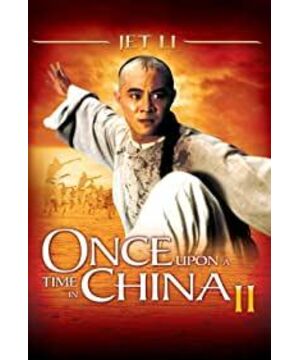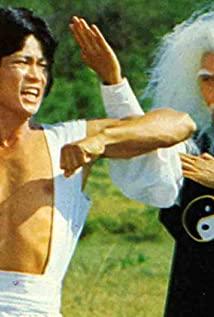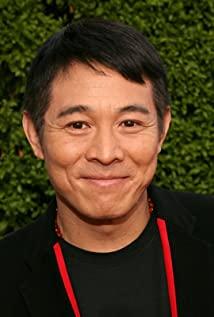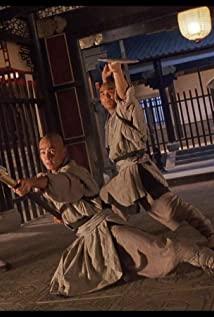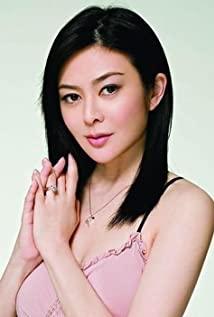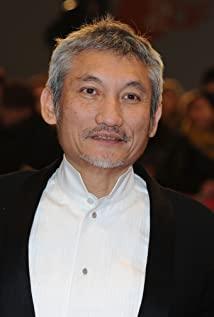(1) The connotation of kung fu movies
The English transliteration of kung fu film is "kung fu film", which generally refers to the type of film with martial arts as the main element. Kung Fu movies have become famous internationally with Bruce Lee, and are even regarded as action-type movies unique to China. Filmmakers familiar to the audience such as Bruce Lee, Jackie Chan, Jet Li, Sammo Hung, Liu Jialiang, and Wu Jing are all representative figures of this type of film.
There are many overlaps between kung fu movies and martial arts movies, martial arts movies, action movies and other concepts, but there are some differences when you look closely. The scholar thought that the relationship between several concepts is that action films > martial arts films > kung fu films > martial arts films
A few examples as simple arguments:
Action movies are a popular type of movie in the world, and English is "Action movie", such as "Hurricane Rescue" in the United States, "Uncle" and "Berlin" in South Korea, and many Japanese samurai movies can be classified into this type. But it is clear that the Chinese will not classify the mentioned movies as kung fu movies and martial arts movies.
Martial arts is our general term for action movies, but it also has some special meanings. For example, in the 1980s, mainland film studios tried to produce films such as "The Mysterious Buddha" (1981), "Wudang" (1983), and "Wulin Zhi" (1989). It is very accurate to call them martial arts films. Many co-production films such as "Shaolin Temple" and "Kapok Robe" are also generally called martial arts films. Because there are many Kung Fu shows in these movies, it is not unreasonable to call them Kung Fu movies, and the two can be regarded as equivalent concepts.
The Chinese Sword-Fighting Movie (see the book The Global Return of the Wuxia pian) is a genre unique to China. In the configuration of "wu" + "xia", Wu is its necessary element and formal feature, and chivalry is its inner spirit. films) side by side with films with distinctive national characteristics. The connotation is the most complex, and the extension is the narrowest.
According to this understanding, the scholars included martial arts films and martial arts films into the category of kung fu films, and defined the scope within Chinese-language films. Of course, it is just for the convenience of understanding, and if it is not rigorous enough, it can be discussed further.
(2) Brief introduction to the development history of kung fu movies
Film scholar Jia Leilei once divided Chinese martial arts films into six sub-types: legends of monsters, biography, ancient costume swords, kung fu fighting, humorous comedy, and magic myth , and pointed out that the appearance of these sub-types has a certain timing. For example, in the period of the Republic of China, martial arts films were mostly legends of gods and monsters; after 1949, biographical films with the theme of Huang Feihong became the main type; in the 1960s and 1970s, there were many costume sword films. Of course, Jia Leilei also pointed out that this division method cannot exhaust all martial arts movies, and in different eras, the types are not replaced by each other, but appear in layers.
For the convenience of understanding, here, only some representative works or representative characters are selected, and a brief summary of kung fu movies is made in accordance with the time sequence.
Before the founding of New China, martial arts films were already an important type of commercial films, and "Burning the Red Lotus Temple" was one of the representative works, which was shown in Xu Haofeng's film "Master".
Beginning in 1949, the "Once Upon a Time" series directed by Hu Peng and starring Guan Dexing was produced and released. By the 1970s, more than 60 films had been produced.
In 1966, Shaw Brothers supported Zhang Che and Hu Jinquan to produce "The One-Armed Swordsman" and "The Drunk Man" respectively, both of which became classics in Chinese film history. The two have produced many martial arts works with different production concepts. There are many director Zhang Che's works, but the good and the bad are mixed. Hu Jinquan's works are not many, and the quality is mostly above the standard. "Chivalrous Girl" even won the Technology Award at the Cannes Film Festival. The two eventually became a generation of masters in the field of martial arts movies.
The 1970s was the golden age of kung fu movies, and it was also the most brilliant period for Zhang Che. Excellent works such as "New One-Armed Swordsman", "Thorn Horse", "Thirteen Taibao" and "The Great Pirate" emerged one after another. Of course, there are also some works. In addition to a large number of kung fu films produced by director Zhang Che, Bruce Lee's four and a half films are internationally renowned; films such as "God Fight" and "Thirty-Six Rooms of Shaolin Temple" directed by Liu Jialiang, who was promoted to director by martial arts director, achieved excellent box office revenue, helping him enter the front line. The ranks of the great guides; Yuan Heping, who was also a martial arts instructor, was supported by Wu Siyuan and directed Jackie Chan to produce "Snake Hands", which was the first to create a humorous and interesting martial arts style; the Gulong movie directed by Chu Yuan also relies on its beautiful style and distinctive lines. Occupy a place in martial arts films, and even started a three-stage naming trend such as "Meteor. Butterfly. Sword".
In the 1980s, kung fu movies in the sense of Zhang Che gradually declined. Hong Kong filmmakers represented by Sammo Hung and Jackie Chan made bold innovations in kung fu movies, such as "Ghost Fighting Ghosts" and "Scaring People" and other humorous ghost movies; "a "Plan", "Police Story" and other police and gangster films; "Summer Lucky Star" represented by the Lucky Star series, which have added a lot of kung fu elements, have been sought after by the audience. During the same period, Liu Jialiang's "Elders", "Goro's Bagua Stick" and "North and South Shaolin" were presented with hard bridges and hard horses, and also occupied a place in the fierce film market.
At the same time, Tsui Hark invited John Woo to produce "The True Color of Heroes", which opened the era of John Woo's "violent aesthetics"; the "Best Partner" series created by Xinyicheng carried forward the themes of kung fu and adventure, and "Seven Little Fortunes" brothers The "Fu Xing" series was bright for a while.
It should be pointed out that since the founding of the People's Republic of China, the mainland has been absent from martial arts films. In the 1980s, "The Mysterious Buddha" became the pioneering work of mainland martial arts films. Since then, major film studios have also produced a number of martial arts films either independently or co-produced, including "Shaolin Temple", "Kapok Robe" and "Wulin Zhi". Movies become the collective memory of a generation.
In the early 1990s, Tsui Hark invited Hu Jinquan to direct "Swordsman", which opened the era of Tsui Hark's new martial arts school. After that, he invited Jet Li and Zhao Wenzhuo to participate in the "Once Upon a Time" series, which became the representative works of martial arts films in this period. The series of "New Dragon Inn", "New Crane Needle" and "Swordsman" series produced by him are quite popular with audiences. "Knife" also became a strange flower in this period because of its unique style.
After establishing a firm foothold in Hong Kong, Jet Li participated in or independently produced a series of works such as "Fang Shiyu", "Tai Chi Zhang Sanfeng", "Letter to Dad", "Hong Xiguan", "Zhongnanhai Bodyguard" and other works. With the prosperity of the video hall, he entered the public. vision.
In the 1990s, Jackie Chan once again attracted the attention of Hollywood with the movie "Red Zone", and then participated in the production of a series of international Kung Fu movies such as "Rush Hour" and "Shanghai Noon", becoming another international actor after Bruce Lee. Kung fu superstar of reputation.
At the same time, Yuan Heping's "Once Upon a Time in the Iron Horse" and "Heroes of Jingwu" solidified his position as the "first martial artist". Subsequently, it went international through The Matrix and Kill Bill.
In 1998, the movie "Fighting in the World" was released and achieved good box office revenue. The use of large-scale computer special effects also improved the production level of martial arts movies. However, with the departure of talents and the sluggish market, the decline of Hong Kong movies is gradually showing. "The Hero of the World" is a representative work of kung fu movies in the 1990s, and it has also become the end of an era.
Entering the new millennium, Tsui Hark's "New Shushan Biography" failed miserably at the box office, and the subsequent production of "Seven Swords" was not satisfactory at the box office. When the "Flying Swords of Dragon Gate" and "Di Renjie" series were successful, Tsui Hark has grayed his hair.
In 2000, Ang Lee's "Crouching Tiger, Hidden Dragon" won the Oscar for Best Foreign Language Film and grossed more than $200 million at the box office. Ignite the enthusiasm of the Chinese film circle for costume blockbusters. Subsequently, Zhang Yimou's "Hero" opened the era of blockbuster Chinese films.
However, during this period, the quantity and quality of kung fu films in Hong Kong films were not comparable to those of the past. In addition to Jackie Chan's stable output and a certain level of quality, both audiences and creators' enthusiasm for kung fu movies is waning.
During this period, Jet Li participated in the production of "Huo Yuanjia", Chen Kexin participated in the production of "Famous Name" and "October Siege", Donnie Yen participated in the production of "Dragon Tiger Gate" and "Fuse", Sammo Hung participated in the production of "Dragon", Ye Weixin Films such as "Slaying the Wolf" and "Ip Man" series that participated in the production all have a certain production level and are recognized by the audience. It should be noted that Zhou Xingchi's film "Kung Fu" was a wonderful work in this period, but Xingye then turned to work behind the scenes, and no subsequent works appeared.
After 2010, Tsui Hark integrated 3D film technology into martial arts film production and successfully launched the "Di Renjie" series. Two films have been released so far. Another possibility of martial arts movies; Xu Haofeng's "Trails of Japanese Pirates", "Master" and "Arrower Willow White Ape" are novel and unique in terms of film language, which is an alternative in martial arts movies; Lu Yang's "Embroidered Spring Knife" series is amazing The world is also maturing; Jackie Chan maintains the quantity and diversity of kung fu films, and the quality is above the standard. "Lion", joined the concept of family affection to produce "British Showdown" and "Blood of the Machine"; Wu Jing integrated kung fu into modern military genre films, produced the "Wolf Warrior" series, and "Wolf Warrior 2" even created the box office of Chinese movies. Miracle, became a phenomenal film.
From this simple combing, we can see that kung fu movies are changing with the times. Overall: 1. In the increasingly fierce market competition, kung fu movies need to incorporate more elements to ensure their survivability and competitiveness, and it is becoming more and more difficult to find a pure kung fu show-type movie; 2. Traditionally, compared with the speculative practice of not enough plots, the audience's requirements for the plot of kung fu movies have become more and more strict, and they have higher requirements for the ideology beyond the action of the movie; 3. With the progress of the film industry, new Action presentation methods and techniques are more used in kung fu movies.
The scholar believes that kung fu movies are a type of popular art, and first of all, they need to be appreciated by the public; secondly, good action presentation is the foundation; finally, it is necessary to have a reasonable plot setting, and the ideology of the movie is the most important blessing item. Considering the three aspects of popularity, action performance and ideology, the scholar believes that "Once Upon a Time" is the best kung fu movie.
(3) Kung Fu is a killing skill, martial arts is a literati skill, and Tsui Hark is a film technician with literati feelings
Most of the writers of martial arts novels are literati, and the world of martial arts comes from the imagination of literati. As shown in Xu Haofeng's research: the real existence of similar behavior groups in history should be summarized by martial arts. For a long time, warriors included generals and soldiers, as well as bodyguards, porters, martial arts halls and martial arts. It is too much to insist on letting martial artists create martial arts novels; and hoping to use the camera to recreate the true face of martial arts, it may break our understanding of martial arts characters. Imagine a historical scene where a knight runs for a living during the day and worries about the morality of the rivers and lakes at night. Is it a scene where you don't have to make money with our knights, but live in an inn, drink meat, fall in love, or run around for the grudges of your parents and teachers? has a difference. Therefore, martial arts is a literati skill, and the rivers, lakes and martial arts landscapes in the martial arts world are more based on the imagination of literati.
Although martial arts novels have a lot of fictional elements, the real value of martial arts novels cannot be denied.
Judging from the activity space of martial arts: martial arts and rivers and lakes are close to the same concept. But in fact, there is a difference between the two. Jianghu is more like a jungle state that is out of the normal order of society. Although there are knights in the rivers and lakes, there are many people who robber and kill people, so there are many dangers, and the dangers of the rivers and lakes are the consensus of the people in the martial arts to a certain extent; martial arts is more like a circle composed of various schools and organizations. Wulin has its own symbol system, and people in martial arts attach great importance to personal names. Because the name includes one's own strength, record, and background, these add up to personal fame.
The literati's setting of the martial arts world determines the space for the activities of the knights, and to a certain extent represents the author's intention and even the realm.
Take Jin Yong's "Swordsman" as an example. In a small way, the Huashan faction, the Wuyuejian faction, and the martial arts form an echeloned organization. Although the activity space of the knights overlaps with the country, the grievances and grievances of the rivers and lakes are also attached to the disputes of the martial arts. The rivers and lakes here can be understood as various circles such as the corporate circle and the academic circle; in a big way, martial arts is actually a In the space of political activities, the grievances and grievances of the rivers and lakes are more like the reflection of the politics of power in the martial arts world, and the so-called unification of the rivers and lakes, alliances or divisions are also political activities of actors centered on political power.
From this perspective, the strength of the relationship between the martial arts world and the real world is weaker or stronger; the embodiment of reality or history is more or less; the realm of the creator is higher or lower, and so on.
The rivers and lakes set by Tsui Hark have a clear concern for history, and many characters have historical prototypes. Therefore, the martial arts world in which Huang Feihong lives has a certain sense of reality. He is constrained by various political, social forces and various rules, and he cannot be happy with enmity. Tsui Hark's martial arts are imaginative, but the background is set in a more realistic way, which provides a window for us to explore the creator's cognition and judgment of characters from all walks of life in the film. Through the analysis of the composition, character and behavior of the characters in the film, we can see the creator's cognition, judgment and attitude towards the characters in a specific period.
Judging from the text of the film, Tsui Hark held a complex emotion towards the old feudal forces, including compassion, resentment and helplessness. This kind of complex emotion is not only reflected in the first part, when Huang Feihong saw Yan Zhendong lamenting that "no matter how good kung fu is, he can't beat a foreign gun", Huang Feihong's regret is also expressed in his sympathy for Nalan Yuanshu and the helplessness of believers in superstitious religions;
Regarding the revolution, Tsui Hark made Huang Feihong grow from a passive cognizant of tolerance in the beginning to an active supporter of the revolution. Tsui Hark projected his beautiful imagination of knights on Huang Feihong, and created an image of an enlightened scholar with high skills with family feelings and a relatively open mind. Many plots in the film also express this attitude: the plot of combining traditional Chinese and Western medicine to heal foreigners expresses the creator's feelings for an open gentleman, neither flattering nor blindly xenophobic; Huang Feihong protects the banner of the revolution, but also represents Xu. Graves sympathy and support for the revolutionaries; Huang Feihong uses traditional Chinese medicine to treat diseases, and uses Chinese martial arts to strengthen the body and protect the family and the country. It also represents the identification and adherence to the national culture.
It can be seen that Tsui Hark's literati sentiments endow the film with historical depth. He takes the new elite represented by the enlightened gentry as the object that the revolution can absorb and rely on, and the people as the object of salvation, which also reflects the inherent elite in the literati complex. orientation.
One of the great things about "Men Be Self-improvement" is that Tsui Hark wrapped his literati feelings with martial arts, and fully expounded his cognition and attitude towards modern history and characters in history through martial arts.
(4) Portraits of Chinese people in "Men Be Self-improvement"
"Once Upon a Time" is the second film in the Wong Fei-hung series led by Tsui Hark in the 1990s. The scholar feels that this film is the best work in this series.
The film not only has a first-class martial arts scene, but also unfolds the landscape of saving the country from all walks of life in the background of the national disaster. The scene is wonderful and the connotation is rich. Therefore, it is also the best kung fu movie in the minds of scholars.
The story of "Men Be Self-improvement" takes place in the late Qing Dynasty. At that time, the national strength of the Qing Dynasty was declining, and domestic and foreign difficulties were encountered. "Saving the country and protecting the species" became the theme of the times. Feudal monarchical forces, peasant forces, professional revolutionaries, and enlightened squires have all stepped onto the historical front.
Jiugong Zhenren: The representative of the peasant power in the old society, borrowing religion to win over believers, ignoring the masses, blindly xenophobic, pathetic and pitiful;
Nalan Yuanshu: The representative of the feudal conservative forces, looking at the devastated country, has the vision of economical and economic benefits, and hopes to maintain social order and strive for national independence within the old system;
Lu Haodong: A representative of a professional revolutionary from an intellectual background, he is full of enthusiasm to save the people, but after seeing the ignorant people, he feels despair;
Sun Wen: He is a professional revolutionary like Lu Haodong. The difference between the two is that Sun Wen's science is hanging on the pot to help the world, but he has achieved the leap from medical people to "medical people", which is the hope of the future Chinese revolution;
Huang Feihong: The representative of enlightened gentlemen, who opposes the blind xenophobia of the peasant class, opposes the demagogic power of religion, opposes the patriotic behavior of feudal ignorance of the rule of law, sympathizes with the revolutionaries, and maintains an open attitude to the new things represented by Western medicine.
The excellence of "Men Be Self-improvement" is that he not only represented these famous and sexual characters, but also more profoundly presented the group portraits of people from all walks of life in the late Qing Dynasty. The little girl with a lantern at the beginning became a victim of religious forces, while a group of mad believers with talisman water shouted for divine power to protect the body, but suffered enormous suffering. Revolutionary Lu Haodong raised his arms and no one responded. Instead, Huang Feihong pretended to be a ghost and pretended to be possessed by Emperor Zhenwu to break the idol of Jiugong Zhenren.
Suffering people need to be saved, but they are also a source of power for social change. Lu Haodong's despair lies in the ignorance of the believers beyond his imagination. In the age of undeveloped people, are these people really worth saving or relying on? This is the depth of the film.
(5) The excellence of "Men Be Self-improvement" also lies in its larger pattern and larger feelings compared with ordinary martial arts works.
"The greatest hero is for the country and the people." Jin Yong's "The Legend of the Condor Heroes" in Jin Yong's martial arts perfectly illustrates this martial arts concept.
"Huang Feihong's Man Becoming Self-improvement" is a good interpretation of this big pattern and big feelings through images.
Compared with typical revenge-style martial arts movies such as Zhang Che's "Revenge" and "One-Armed Swordsman", "Once Upon a Time" has more family and country feelings;
Compared with pure kung fu movies in the typical sense, such as Liu Jialiang's Thirty-Six Rooms of Shaolin Temple and The Master of the Shelter, the pattern and theme of "Once Upon a Time" are more grand;
Compared with the typical humorous martial arts movies such as "Food Truck" and "City Hunter", "Once Upon a Time" is better in ideological aspects;
Compared with kung fu films with the theme of nationalism in the typical sense, such as "Wulin Zhi", "Huo Yuanjia", "Fighting Heroes" and "Ip Man 1/2", "Once Upon a Time in Man" shows the faces of various characters in the society. The display, recognition and absorption of foreign science and technology and martial arts skills are more complete and in-depth.
It should be noted that in recent years, there are new martial arts works represented by "The Trail of the Japanese Pirates", "Master", "The Swordsman Willow White Ape", "The Grand Master" and "Embroidered Spring Knife".
Xu Haofeng is one of the few directors in China who learns and understands it before starting to make a movie. Xu Haofeng believes that "the basis of genre films is not audio-visual dazzling skills or star parties, but public psychology. Only when there is panic and redemption can a genre be established. Each genre film has its own knowledge system, and westerns are firearms. Knowledge and wandering skills, romance films are about women’s psychology and family culture, and martial arts films are about ritual music.” The panic of martial arts films is the panic of literati—“rites are broken and music is broken”. Although this kind of exploration of the value core of martial arts movies is quite meaningful, the paranoia about "ceremony and music" reflects Xu Haofeng's elite English vision. His display of real martial arts rules and behaviors made his films lack the market spirit that ordinary kung fu films should have, showing more than academy and lack of spiritual energy;
"The Grand Master" also showed the martial arts style of the Republic of China, but the glasses of the glasses brother not only filtered the clutter he thought, but also gave the film a strong petty bourgeoisie tone, exquisite, beautiful, and too one-sided;
"Embroidered Spring Knife" also substitutes martial arts into the situation of the times, but the author is obviously unwilling to delay too long on macro issues of home and country. The survival dilemma and choices of the little people are the focus of the creator.
That is to say
Xu Haofeng is more like a teacher, using films to show what he thinks is the martial arts landscape, as well as his retrospect and reflection on the rules and order in Chinese culture. The idea is too high, and it appears to be high and arrogant;
Wong Kar-wai is proficient in pondering and is an excellent film technician. He can make all types of films according to his own style, and "The Grandmaster" is no exception;
Lu Yang's "Embroidered Spring Knife" is a rare surprise for newcomers in kung fu films in recent years, but the rivers and lakes in his films are embedded in the officialdom. Although the behavior of small bureaucrats has affected the big era, such a setting is very similar to a workplace movie. In the environment of profit-oriented and speculation, pure love, sincere brotherhood and persistence in professional ethics have become deserts. The clear spring is precious and beautiful, but that's all.
As for movies such as "Crouching Tiger, Hidden Dragon" and "Hero", scholars think that they should not be included in the category of martial arts films in the typical sense. After all, Mr. Xu Haofeng pointed out that Ang Lee's "Crouching Tiger, Hidden Dragon" talks about It is a love story of Li Mubai. Fighting in the bamboo forest uses the techniques of bed scenes to deal with martial arts; Zhang Yimou's "Hero" is more like the scene handling skills of Kurosawa Akira in "Shadow Warrior" and other movies plus the "Rashomon". A movie with a narrative structure, if you say this is a kung fu movie, the national teacher will be smoking.
Finally, it should be noted that the scholars liked the martial arts works of Hu Jinquan and Mr. Zhang Che very much, such as "Chivalrous Girl", "Dragon Inn", "Loyalty", "Empty Mountain Lingyu"; I like it very much, but these films are old, and the smoothness of the action is not the same as today; the other is that although there have been obvious changes in the presentation of the action and the way of narration in Hong Kong Kung Fu movies, there are differences between the creators. certain inheritance. Tsui Hark himself is a fan of Master Hu. Although Xu's works are different from Mr. Hu Jinquan's rigorous style, he does integrate Hu Jinquan's martial arts thinking about reality and history, and in some actions and plots The handling is even better than the blue.
Therefore, as far as the best kung fu movies are concerned, the scholar stands with Tsui Hark, and the top "Once Upon a Time of Man".
references:
1. Jia Leilei. History of Chinese martial arts films [M]. Culture and Art Press, 2005.
2. Xu Haofeng. Knives and Stars: Xu Haofeng's Film Critic Collection[M]. World Book Publishing Company, 2012.
3. Yan Hong. On Hu Jinquan's position in the history of Chinese martial arts films [J]. Film Literature, 2014, No.603(6):29-30.
4. Jia Leilei. Historical naming and genre evolution of Chinese martial arts films [J]. Film Art, 2017(5):3-8.
5. Zhang Y. A companion to Chinese cinema [M] Wiley-Blackwell, 2012.
6. Teo S. Chinese Martial Arts Cinema: The Wuxia Tradition[M]. Edinburgh University Press, 2009.
View more about Once Upon a Time in China II reviews


